 |
CHAPTER
XX.
EARLY
RENAISSANCE ARCHITECTURE IN ITALY.
BOOKS RECOMMENDED: Anderson, Architecture
of the Renaissance in
Italy.
Burckhardt,
The
Civilization of the
Renaissance;
Geschichte
der Renaissance in
Italien;
Der
Cicerone.
Cellesi, Sei
Fabbriche di Firenze.
Cicognara, Le
Fabbriche più cospicue di
Venezia.
Durm, Die
Baukunst der Renaissance in
Italien (in
Hdbuch.
d. Arch.).
Fergusson,
History
of Modern Architecture.
Geymüller, La
Renaissance en Toscane.
Montigny
et Famin, Architecture
Toscane.
Moore, Character
of Renaissance
Architecture. Müntz,
La
Renaissance en Italie et en France à
l'époque de Charles
VIII.
Palustre,
L'Architecture
de la Renaissance.
Pater, Studies
in the Renaissance.
Symonds,
The
Renaissance of the Fine Arts
in Italy.
Tosi and Becchio, Altars,
Tabernacles, and
Tombs.
THE
CLASSIC REVIVAL. The
abandonment of Gothic architecture in
Italy and the
substitution
in its place of forms
derived from classic models
were occasioned by no
sudden
or merely local revolution. The
Renaissance was the result of a
profound and
universal
intellectual movement, whose
roots may be traced far back into the
Middle
Ages,
and which manifested itself first in
Italy simply because there the
conditions
were
most propitious. It spread through
Europe just as rapidly as similar
conditions
appearing
in other countries prepared the way for
it. The essence of this
far-reaching
movement
was the protest of the individual
reason against the trammels of
external
and
arbitrary authority--a protest which found
its earliest organized
expression in
the
Humanists. In its assertion of the
intellectual and moral rights of the
individual,
the
Renaissance laid the foundations of
modern civilization. The same
spirit, in
rejecting
the authority and teachings of the Church in
matters of purely secular
knowledge,
led to the questionings of the precursors
of modern science and the
discoveries
of the early navigators. But in nothing
did the reaction against
mediæval
scholasticism
and asceticism display itself
more strikingly than in the joyful
enthusiasm
which marked the pursuit of classic
studies. The long-neglected
treasures
of
classic literature were
reopened, almost rediscovered, in the
fourteenth century by
the
immortal trio--Dante, Petrarch, and
Boccaccio. The joy of living, the
hitherto
forbidden
delight in beauty and pleasure for their
own sakes, the exultant
awakening
to
the sense of personal freedom, which
came with the bursting of mediæval
fetters,
found
in classic art and literature their most
sympathetic expression. It was in
Italy,
where
feudalism had never fully established
itself, and where the municipalities
and
guilds
had developed, as nowhere else, the
sense of civic and personal
freedom, that
these
symptoms first manifested
themselves. In Italy, and above all in the
Tuscan
cities,
they appeared throughout the fourteenth
century in the growing
enthusiasm
for
all that recalled the antique culture,
and in the rapid advance of luxury
and
refinement
in both public and private
life.
THE
RENAISSANCE OF THE ARTS. Classic
Roman architecture had never
lost its
influence
on the Italian taste. Gothic art,
already declining in the West, had
never
been
in Italy more than a borrowed garb,
clothing architectural conceptions
classic
rather
than Gothic in spirit. The antique
monuments which abounded on every
hand
were
ever present models for the
artist, and to the Florentines of the
early fifteenth
century
the civilization which had created them
represented the highest ideal
of
human
culture. They longed to revive in
their own time the glories of
ancient Rome,
and
appropriated with uncritical and
undiscriminating enthusiasm the good and
the
bad,
the early and the late forms of
Roman art, Naïvely unconscious of the
disparity
between
their own architectural conceptions and
those they fancied they
imitated,
they
were, unknown to themselves, creating a
new style, in which the details of
Roman
art were fitted in novel
combinations to new requirements. In
proportion as
the
Church lost its hold on the
culture of the age, this new architecture
entered
increasingly
into the service of private luxury and
public display. It created, it is
true,
striking
types of church design, and made of the
dome one of the most
imposing of
external
features; but its most
characteristic products were
palaces, villas,
council
halls,
and monuments to the great and the
powerful. The personal element in
design
asserted
itself as never before in the growth of
schools and the development of
styles.
Thenceforward
the history of Italian architecture
becomes the history of the
achievements
of individual artists.
EARLY
BEGINNINGS. Already
in the 13th century the pulpits of Niccolo
Pisano at
Sienna
and Pisa had revealed that master's
direct recourse to antique
monuments for
inspiration
and suggestion. In the frescoes of Giotto
and his followers, and in the
architectural
details of many nominally Gothic
buildings, classic forms had
appeared
with
increasing frequency during the
fourteenth century. This was
especially true in
Florence,
which was then the artistic capital of
Italy. Never, perhaps, since the
days
of
Pericles, had there been
another community so permeated with the
love of beauty
in
art, and so endowed with the capacity to
realize it. Nowhere else in
Europe at that
time
was there such strenuous
life, such intense feeling,
or such free course
for
individual
genius as in Florence. Her artists, with
unexampled versatility,
addressed
themselves
with equal success to goldsmiths' work,
sculpture, architecture and
engineering--often
to painting and poetry as well; and they
were quick to catch
in
their
art the spirit of the classic revival.
The new movement achieved its
first
architectural
triumph in the dome of the cathedral of
Florence (142064); and it was
Florentine--or
at least Tuscan--artists who planted in
other centres the seeds of
the
new
art that were to spring up in the local
and provincial schools of Sienna,
Milan,
Pavia,
Bologna, and Venice, of Brescia,
Lucca, Perugia, and Rimini, and many
other
North
Italian cities. The movement asserted
itself late in Rome and
Naples, as an
importation
from Northern Italy, but it bore abundant fruit in
these cities in its
later
stages.
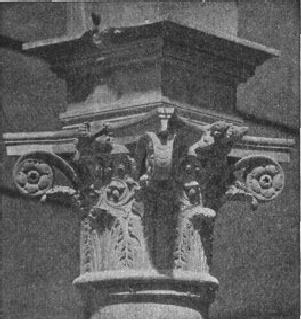
PERIODS.
The
classic styles which grew up out of the
Renaissance may be divided
for
convenience into four periods.
THE EARLY RENAISSANCE or
FORMATIVE
PERIOD,
142090; characterized by the
grace
and
freedom of the decorative detail,
suggested by Roman prototypes and
applied to
compositions
of great variety and
originality.
THE HIGH
RENAISSANCE or
FORMALLY
CLASSIC PERIOD, 14901550. During this
period
classic
details were copied with
increasing fidelity, the orders
especially appearing in
almost
all compositions; decoration meanwhile
losing somewhat in grace
and
freedom.
THE EARLY BAROQUE (or BAROCO), 15501600; a period
of classic formality
characterized
by the use of colossal orders,
engaged columns and rather
scanty
decoration.
THE DECLINE or
LATER
BAROQUE,
marked by poverty of invention in the
composition
and
a predominance of vulgar sham and
display in the decoration. Broken
pediments,
huge
scrolls, florid stucco-work and a
general disregard of architectural
propriety
were
universal.
During
the eighteenth century there was a
reaction from these extravagances,
which
showed
itself in a return to the servile copying
of classic models, sometimes
not
without
a certain dignity of composition and
restraint in the decoration.
By
many writers the name Renaissance is
confined to the first period.
This is correct
from
the etymological point of view; but it is impossible
to dissociate the first
period
historically
from those which followed it, down to the final
exhaustion of the artistic
movement
to which it gave birth, in the heavy
extravagances of the Rococo.
FIG.
158.--EARLY RENAISSANCE CAPITAL,
PAL. ZORZI, VENICE.
Another
division is made by the Italians, who
give the name of the Quattrocento
to
the
period which closed with the end of the
fifteenth century, Cinquecento
to
the
sixteenth
century, and Seicento
to the
seventeenth century or Rococo. It
has,
however,
become common to confine the
use of the term Cinquecento to the first
half
of
the sixteenth century.
CONSTRUCTION
AND DETAIL. The
architects of the Renaissance
occupied
themselves
more with form than with construction, and
rarely set themselves
constructive
problems of great difficulty. Although
the new architecture began with
the
colossal dome of the cathedral of
Florence, and culminated in the
stupendous
church
of St. Peter at Rome, it was
pre-eminently an architecture of palaces
and
villas,
of façades and of decorative display.
Constructive difficulties were
reduced to
their
lowest terms, and the constructive
framework was concealed, not
emphasized,
by
the decorative apparel of the design.
Among the masterpieces of the
early
Renaissance
are many buildings of small
dimensions, such as gates,
chapels, tombs
and
fountains. In these the individual
fancy had full sway, and produced
surprising
results
by the beauty of enriched mouldings, of
carved friezes with infant
genii,
wreaths
of fruit, griffins, masks and scrolls; by
pilasters covered with arabesques
as
delicate
in modelling as if wrought in silver; by
inlays of marble, panels of
glazed
terra-cotta,
marvellously carved doors,
fine stucco-work in relief,
capitals and
cornices
of wonderful richness and variety. The
Roman orders appeared only in
free
imitations,
with panelled and carved pilasters for
the most part instead of
columns,
and
capitals of fanciful design,
recalling remotely the Corinthian by
their volutes and
leaves
(Fig. 158). Instead of the low-pitched
classic pediments, there
appears
frequently
an arched cornice enclosing a
sculptured lunette. Doors and
windows
were
enclosed in richly carved frames,
sometimes arched and sometimes
square.
Façades
were flat and unbroken, depending mainly
for effect upon the distribution
and
adornment of the openings, and the design
of doorways, courtyards and
cornices.
Internally vaults and flat ceilings of
wood and plaster were about
equally
common,
the barrel vault and dome occurring far
more frequently than the
groined
vault.
Many of the ceilings of this period are
of remarkable richness and
beauty.
THE
EARLY RENAISSANCE IN FLORENCE: THE DUOMO.
In the
year 1417 a
public
competition was held for
completing the cathedral of Florence by a
dome over
the
immense octagon, 143 feet in
diameter. Filippo
Brunelleschi,
sculptor and
architect
(13771446), who with Donatello had journeyed to
Rome to study there
the
masterworks of ancient art, after
demonstrating the inadequacy of all
the
solutions
proposed by the competitors, was finally
permitted to undertake the
gigantic
task according to his own
plans. These provided for an
octagonal dome in
two
shells, connected by eight
major and sixteen minor ribs, and
crowned by a
lantern
at the top (Fig. 159). This wholly
original conception, by which for the
first
time
(outside of Moslem art) the
dome was made an external
feature fitly terminating
in
the light forms and upward movement of a
lantern, was carried out
between the
years
1420 and 1464. Though in no wise an imitation of
Roman forms, it was
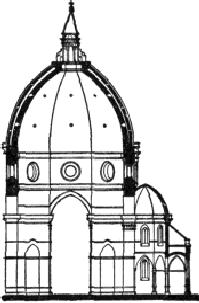
classic
in its spirit, in its
vastness and its simplicity of
line, and was made
possible
solely
by Brunelleschi's studies of Roman
design and construction (Fig.
160).
FIG.
159.--SECTION OF DOME OF DUOMO,
FLORENCE.
OTHER
CHURCHES. From
Brunelleschi's designs were
also erected the Pazzi
Chapel
in
Sta. Croce, a charming
design of a Greek cross
covered with a dome at the
intersection,
and preceded by a vestibule with a richly
decorated vault; and the two
great
churches of S.
Lorenzo (1425) and
S.
Spirito (14331476,
Fig. 161). Both
reproduced
in a measure the plan of the Pisa
Cathedral, having a three-aisled
nave
and
transepts, with a low dome over the
crossing. The side aisles
were covered with
domical
vaults and the central aisles with flat
wooden or plaster ceilings. All
the
details
of columns, arches and mouldings
were imitated from Roman
models, and yet
the
result was something
entirely new. Consciously or
unconsciously, Brunelleschi
was
reviving Byzantine rather than
Roman conceptions in the planning and
structural
design
of these domical churches, but the
garb in which he clothed them was
Roman,
at
least in detail. The Old
Sacristy of S.
Lorenzo was another domical
design of great
beauty.
From
this time on the new style was in
general use for church designs.
L.
B. Alberti
(140473),
who had in Rome mastered classic
details more thoroughly
than
Brunelleschi,
remodelled the church of S.
Francesco at
Rimini
with
Roman pilasters
and
arches, and with engaged orders in the
façade, which, however, was
never
completed.
His great work was the church of
S.
Andrea at
Mantua, a
Latin cross in
plan,
with a dome at the intersection (the
present high dome dating
however, only
from
the 18th century) and a façade to which the
conception of a Roman triumphal
arch
was skilfully adapted. His façade of
incrusted marbles for the church of S.
M.
Novella
at Florence was a less
successful work, though its flaring
consoles over the
side
aisles established an unfortunate
precedent frequently imitated in
later churches.
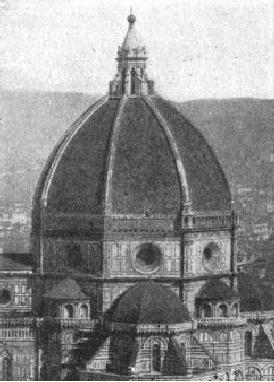
FIG.
160.--EXTERIOR OF DOME OF DUOMO,
FLORENCE.
A
great activity in church-building
marked the period between 1475 and 1490.
The
plans
of the churches erected about this
time throughout north Italy display
an
interesting
variety of arrangements, in nearly all of
which the dome is combined with
the
three-aisled cruciform plan, either as a
central feature at the crossing or as
a
domical
vault over each bay. Bologna and
Ferrara possess a number of churches
of
this
kind. Occasionally the basilican
arrangement was followed, with
columnar
arcades
separating the aisles. More often,
however, the pier-arches were of
the
Roman
type, with engaged columns or
pilasters between them. The
interiors,
presumably
intended to receive painted
decorations, were in most
cases somewhat
bare
of ornament, pleasing rather by
happy proportions and effective
vaulting or rich
flat
ceilings, panelled, painted and
gilded, than by elaborate architectural
detail.
A
similar scantiness of ornament is to be
remarked in the exteriors, excepting
the
façades,
which were sometimes highly ornate; the
doorways, with columns,
pediments,
sculpture and carving, receiving
especial attention. High external
domes
did
not come into general use until the next
period. In Milan, Pavia, and some
other
Lombard
cities, the internal cupola
over the crossing was,
however, covered
externally
by a lofty structure in diminishing
stages, like that of the Certosa at
Pavia
(Fig.
152), or that erected by Bramante for the church of S.
M. delle Grazie at Milan.
At
Prato, in the church of the Madonna
delle Carceri (14951516),
by Giuliano
da
S.
Gallo, the type of
the Pazzi chapel reappears in a
larger scale; the plan is
cruciform,
with equal or nearly equal
arms covered by barrel
vaults, at whose
intersection
rises a dome of moderate
height on pendentives. This
charming edifice,
with
its unfinished exterior of white
marble, its simple and
dignified lines, and
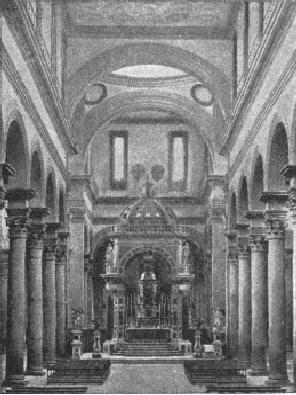
internal
embellishments in della-Robbia ware, is
one of the masterpieces of the
period.
FIG.
161.--INTERIOR OF S. SPIRITO,
FLORENCE.
In
the designing of chapels and oratories
the architects of the early
Renaissance
attained
conspicuous success, these
edifices presenting fewer
structural limitations
and
being more purely decorative in
character than the larger churches.
Such façades
as
that of S.
Bernardino at
Perugia and of the Frati
di S. Spirito at
Bologna are
among
the most delightful products of the
decorative fancy of the 15th
century.
FLORENTINE
PALACES. While
the architects of this period failed to
develop any
new
and thoroughly satisfactory
ecclesiastical type, they attained
conspicuous
success
in palace-architecture. The Riccardi
palace
in Florence (1430) marks the
first
step
of the Renaissance in this direction. It
was built for the great Cosimo di
Medici
by
Michelozzi
(13971473),
a contemporary of Brunelleschi and
Alberti, and a man
of
great talent. Its imposing
rectangular façade, with widely spaced
mullioned
windows
in two stories over a massive
basement, is crowned with a classic
cornice of
unusual
and perhaps excessive size. In
spite of the bold and fortress-like
character of
the
rusticated masonry of these
façades, and the mediæval look they
seem to present
to
modern eyes, they marked a
revolution in style and established a
type frequently
imitated
in later years. The courtyard, in
contrast with this stern exterior,
appears
light
and cheerful (Fig. 162). Its wall is
carried on round arches borne by
columns
with
Corinthianesque capitals, and the arcade
is enriched with sculptured
medallions.
The
Pitti Palace, by
Brunelleschi (1435), embodies the same
ideas on a
more
colossal scale, but lacks the
grace of an adequate cornice. A
lighter and more
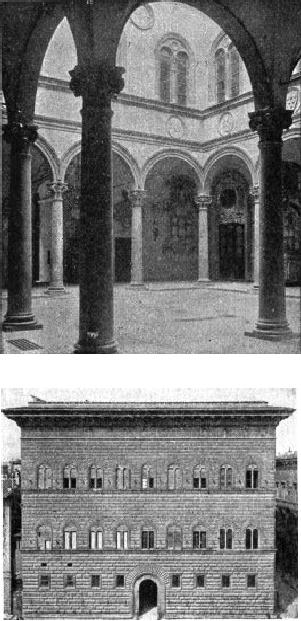
ornate
style appeared in 1460 in the P.
Rucellai, by
Alberti, in which for the first
time
classical pilasters in superposed
stages were applied to a
street façade. To
avoid
the
dilemma of either insufficiently
crowning the edifice or making the
cornice too
heavy
for the upper range of pilasters,
Alberti made use of
brackets, occupying the
width
of the upper frieze, and converting the
whole upper entablature into a
cornice.
But
this compromise was not quite
successful, and it remained for later
architects in
Venice,
Verona, and Rome to work out more
satisfactory methods of applying
the
orders
to many-storied palace façades. In the
great P.
Strozzi (Fig.
163), erected in
1490
by Benedetto
da Majano and
Cronaca, the
architects reverted to the earlier
type
of
the P. Riccardi, treating it with greater
refinement and producing one of
the
noblest
palaces of Italy.
FIG.
162.--COURTYARD OF RICCARDI PALACE,
FLORENCE.
FIG.
163.--FAÇADE OF STROZZI PALACE,
FLORENCE.
COURTYARDS;
ARCADES. These
palaces were all built around
interior courts,
whose
walls rested on columnar
arcades, as in the P. Riccardi (Fig.
162). The origin
of
these arcades may be found in the arcaded
cloisters of mediæval
monastic
churches,
which often suggest classic
models, as in those of St.
Paul-beyond-the-
Walls
and St. John Lateran at
Rome. Brunelleschi not only introduced
columnar
arcades
into a number of cloisters and palace
courts, but also used them
effectively
as
exterior features in the Loggia
S. Paolo and the
Foundling Hospital (Ospedale
degli
Innocenti) at
Florence. The chief drawback in
these light arcades was
their
inability
to withstand the thrust of the vaulting
over the space behind them, and
the
consequent
recourse to iron tie-rods where
vaulting was used. The
Italians, however,
seemed
to care little about this
disfigurement.
MINOR
WORKS. The
details of the new style were
developed quite as rapidly
in
purely
decorative works as in monumental
buildings. Altars, mural
monuments,
tabernacles,
pulpits and ciboria
afforded
scope for the genius of the
most
distinguished
artists. Among those who
were specially celebrated in
works of this
kind
should be named Lucca
della Robbia (140082)
and his successors, Mino
da
Fiesole
(143184)
and Benedetto
da Majano (144297).
Possessed of a wonderful
fertility
of invention, they and their pupils
multiplied their works in
extraordinary
number
and variety, not only throughout north Italy, but
also in Rome and
Naples.
Among
the most famous examples of this
branch of design may be mentioned
a
pulpit
in Sta. Croce by B. da Majano; a
terra-cotta fountain in the sacristy of S.
M.
Novella,
by the della Robbias; the Marsupini tomb
in Sta. Croce, by Desiderio
da
Settignano
(all
in Florence); the della Rovere tomb in S.
M. del Popolo, Rome,
by
Mino
da Fiesole, and in the Cathedral at Lucca
the Noceto tomb and the Tempietto,
by
Matteo
Civitali. It
was in works of this character that the
Renaissance oftenest
made
its first appearance in a new
centre, as was the case in
Sienna, Pisa, Lucca,
Naples,
etc.
NORTH
ITALY. Between
1450 and 1490 the Renaissance presented in
Sienna, in a
number
of important palaces, a sharp
contrast to the prevalent Gothic
style of that
city.
The P.
Piccolomini--a
somewhat crude imitation of the P.
Riccardi in
Florence--dates
from 1463; the P.
del Governo was
built 1469, and the Spannocchi
Palace
in 1470. In
1463 Ant.
Federighi built
there the Loggia
del Papa.
About the
same
time Bernardo
di Lorenzo was
building for Pope Pius II.
(Æneas Sylvius
Piccolomini)
an entirely new city, Pienza, with a
cathedral, archbishop's palace,
town
hall
and Papal residence (the
P.
Piccolomini), which
are interesting if not
strikingly
original
works. Pisa possesses few
early Renaissance structures,
owing to the utter
prostration
of her fortunes in the 15th century, and the dominance
of Pisan Gothic
traditions.
In Lucca, besides a wealth of minor
monuments (largely the work of
Matteo
Civitali, 14351501) in various
churches, a number of palaces date
from
this
period, the most important
being the P.
Pretorio and P.
Bernardini. To Milan the
Renaissance
was carried by the Florentine
masters Michelozzi
and
Filarete, to
whom
are
respectively due the Portinari
Chapel in S.
Eustorgio (1462) and the earlier
part
of
the great Ospedale
Maggiore (1457). In the
latter, an edifice of brick with
terra-
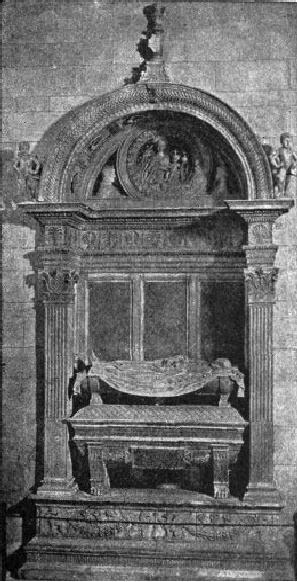
cotta
enrichments, the windows were Gothic in
outline--an unusual mixture of
styles,
even in Italy. The munificence of the
Sforzas, the hereditary tyrants of
the
province,
embellished the semi-Gothic Certosa
of
Pavia with a new marble
façade,
begun
1476 or 1491, which in its fanciful and
exuberant decoration, and the
small
scale
of its parts, belongs
properly to the early Renaissance.
Exquisitely beautiful in
detail,
it resembles rather a magnified
altar-piece than a work of
architecture,
properly
speaking. Bologna and Ferrara
developed somewhat late in the century
a
strong
local school of architecture,
remarkable especially for the beauty of
its
courtyards,
its graceful street arcades,
and its artistic treatment of
brick and terra-
cotta
(P.
Bevilacqua,
P.
Fava, at
Bologna; P.
Scrofa,
P.
Roverella, at
Ferrara). About
the
same time palaces with
interior arcades and details in the new
style were erected
in
Verona, Vicenza, Mantua, and other
cities.
FIG.
164.--TOMB OF PIETRO DI NOCETO,
LUCCA.
VENICE.
In this city
of merchant princes and a wealthy
bourgeoisie, the
architecture
of
the Renaissance took on a new aspect of
splendor and display. It was
late in
appearing,
the Gothic style with its
tinge of Byzantine decorative
traditions having
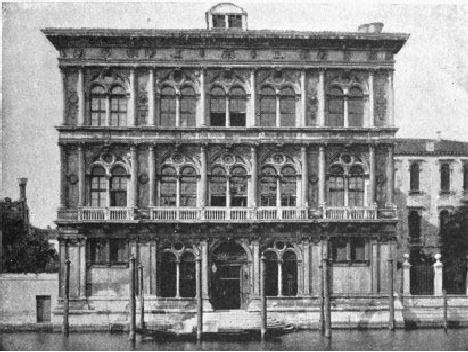
here
developed into a style well suited to the
needs of a rich and relatively
tranquil
community.
These traditions the architects of the
new style appropriated in a
measure,
as in the marble incrustations of the
exquisite little church of S.
M. dei
Miracoli
(148089),
and the façade of the Scuola
di S. Marco (14851533),
both
by
Pietro
Lombardo.
Nowhere else, unless on the
contemporary façade of the
Certosa
at
Pavia, were marble inlays
and delicate carving, combined with a
framework of thin
pilasters,
finely profiled entablatures and arched
pediments, so lavishly
bestowed
upon
the street fronts of churches and
palaces. The family of the Lombardi
(Martino,
his
sons Moro and Pietro, and grandsons
Antonio and Tullio), with Ant.
Bregno and
Bart.
Buon,
were the leaders in the architectural
Renaissance of this period, and to
them
Venice owes her choicest
masterpieces in the new style. Its first
appearance is
noted
in the later portions of the church of
S.
Zaccaria (14561515),
partly Gothic
internally,
with a façade whose semicircular
pediment and small decorative
arcades
show
a somewhat timid but interesting
application of classic details. In this
church,
and
still more so in S. Giobbe (145193)
and the Miracoli above mentioned,
the
decorative
element predominates throughout. It is
hard to imagine details
more
graceful
in design, more effective in the
swing of their movement, or more
delicate in
execution
than the mouldings, reliefs, wreaths,
scrolls, and capitals one
encounters in
these
buildings. Yet in structural interest, in
scale and breadth of planning,
these
early
Renaissance Venetian buildings hold a
relatively inferior rank.
FIG.
165.--VENDRAMINI PALACE,
VENICE.
PALACES.
The
great Court
of the
Doge's
Palace,
begun 1483 by Ant.
Rizzio,
belongs
only in part to the first period. It
shows, however, the lack of
constructive
principle
and of largeness of composition just
mentioned, but its decorative
effect
and
picturesque variety elicit
almost universal admiration.
Like the neighboring
façade
of St. Mark's, it violates nearly
every principle of correct
composition, and yet
in
a measure atones for this capital
defect by its charm of
detail. Far more
satisfactory
from the purely architectural point of view is the
façade of the
P.
Vendramini (Vendramin-Calergi),
by Pietro Lombardo (1481). The simple,
stately
lines
of its composition, the dignity of
its broad arched and
mullioned windows,
separated
by engaged columns--the earliest
example in Venice of this feature,
and
one
of the earliest in Italy--its well-proportioned
basement and upper
stories,
crowned
by an adequate but somewhat heavy
entablature, make this one of the
finest
palaces
in Italy (Fig. 165) It established a type of
large-windowed, vigorously
modelled
façades which later architects
developed, but hardly surpassed. In
the
smaller
contemporary, P. Dario, another type
appears, better suited for
small
buildings,
depending for effect mainly upon
well-ordered openings and
incrusted
panelling
of colored marble.
ROME.
Internal
disorders and the long exile of the
popes had by the end of the
fourteenth
century reduced Rome to utter
insignificance. Not until the second half
of
the
fifteenth century did returning
prosperity and wealth afford the
Renaissance its
opportunity
in the Eternal City. Pope Nicholas V.
had, indeed, begun the
rebuilding
of
St. Peter's from designs by B.
Rossellini, in 1450, but the project
lapsed shortly
after
with the death of the pope. The earliest
Renaissance building in Rome
was the
P.
di Venezia,
begun in 1455, together with the
adjoining porch of S. Marco. In
this
palace
and the adjoining unfinished Palazzetto
we find the influence of the old
Roman
monuments clearly manifested in the court
arcades, built like those of
the
Colosseum,
with superposed stages of massive
piers and engaged columns
carrying
entablatures.
The proportions are awkward, the
details coarse; but the spirit
of
Roman
classicism is here seen in the
germ. The exterior of this palace
is, however,
still
Gothic in spirit. The architects
are unknown; Giuliano
da Majano (145290),
Giacomo
di Pietrasanta, and
Meo
del Caprino (14301501)
are known to have
worked
upon it, but it is not certain in what
capacity.
The
new style, reaching, and in time
overcoming, the conservatism of the
Church,
overthrew
the old basilican traditions. In
S.
Agostino (147983),
by Pietrasanta,
and
S.
M. del Popolo, by
Pintelli (?), piers with
pilasters or half-columns and
massive
arches
separate the aisles, and the crossing is
crowned with a dome. To the
same
period
belong the Sistine chapel and
parts of the Vatican palace, but the
interest of
these
lies rather in their later
decorations than in their somewhat
scanty architectural
merit.
The
architectural renewal of Rome, thus
begun, reached its
culmination in the
following
period.
OTHER
MONUMENTS. The
complete enumeration of even the
most important Early
Renaissance
monuments of Italy is impossible within our
limits. Two or three only
can
here be singled out as suggesting
types. Among town halls of this
period the first
place
belongs to the P.
del Consiglio at
Verona, by Fra
Giocondo (14351515).
In
this
beautiful edifice the façade
consists of a light and graceful arcade
supporting a
wall
pierced with four windows, and covered
with elaborate frescoed
arabesques
(recently
restored). Its unfortunate division by
pilasters into four bays, with a pier
in
the
centre, is a blemish avoided in the
contemporary P.
del Consiglio at
Padua. The
Ducal
Palace at Urbino, by
Luciano
da Laurano (1468), is
noteworthy for its fine
arcaded
court, and was highly famed in
its day. At Brescia S.
M. dei Miracoli is
a
remarkable
example of a cruciform domical church
dating from the close of this
period,
and is especially celebrated for the
exuberant decoration of its
porch and its
elaborate
detail. Few campaniles were
built in this period; the best of them
are at
Venice.
Naples possesses several
interesting Early Renaissance
monuments, chief
among
which are the Porta
Capuana (1484), by
Giul.
da Majano, the
triumphal Arch
of
Alphonso of
Arragon, by Pietro
di Martino, and the
P.
Gravina, by
Gab.
d'Agnolo.
Naples
is also very rich in minor works of the
early Renaissance, in which it
ranks
with
Florence, Venice, and
Rome.
Table of Contents:
- PRIMITIVE AND PREHISTORIC ARCHITECTURE:EARLY BEGINNINGS
- EGYPTIAN ARCHITECTURE:LAND AND PEOPLE, THE MIDDLE EMPIRE
- EGYPTIAN ARCHITECTURE—Continued:TEMPLES, CAPITALS
- CHALDÆAN AND ASSYRIAN ARCHITECTURE:ORNAMENT, MONUMENTS
- PERSIAN, LYCIAN AND JEWISH ARCHITECTURE:Jehovah
- GREEK ARCHITECTURE:GENERAL CONSIDERATIONS, THE DORIC
- GREEK ARCHITECTURE—Continued:ARCHAIC PERIOD, THE TRANSITION
- ROMAN ARCHITECTURE:LAND AND PEOPLE, GREEK INFLUENCE
- ROMAN ARCHITECTURE—Continued:IMPERIAL ARCHITECTURE
- EARLY CHRISTIAN ARCHITECTURE:INTRODUCTORY, RAVENNA
- BYZANTINE ARCHITECTURE:DOMES, DECORATION, CARVED DETAILS
- SASSANIAN AND MOHAMMEDAN ARCHITECTURE:ARABIC ARCHITECTURE
- EARLY MEDIÆVAL ARCHITECTURE:LOMBARD STYLE, FLORENCE
- EARLY MEDIÆVAL ARCHITECTURE.—Continued:EARLY CHURCHES, GREAT BRITAIN
- GOTHIC ARCHITECTURE:STRUCTURAL PRINCIPLES, RIBBED VAULTING
- GOTHIC ARCHITECTURE IN FRANCE:STRUCTURAL DEVELOPMENT
- GOTHIC ARCHITECTURE IN GREAT BRITAIN:GENERAL CHARACTER
- GOTHIC ARCHITECTURE IN GERMANY, THE NETHERLANDS, AND SPAIN
- GOTHIC ARCHITECTURE IN ITALY:CLIMATE AND TRADITION, EARLY BUILDINGS.
- EARLY RENAISSANCE ARCHITECTURE IN ITALY:THE CLASSIC REVIVAL, PERIODS
- RENAISSANCE ARCHITECTURE IN ITALY—Continued:BRAMANTE’S WORKS
- RENAISSANCE ARCHITECTURE IN FRANCE:THE TRANSITION, CHURCHES
- RENAISSANCE ARCHITECTURE IN GREAT BRITAIN AND THE NETHERLANDS
- RENAISSANCE ARCHITECTURE IN GERMANY, SPAIN, AND PORTUGAL
- THE CLASSIC REVIVALS IN EUROPE:THE EIGHTEENTH CENTURY
- RECENT ARCHITECTURE IN EUROPE:MODERN CONDITIONS, FRANCE
- ARCHITECTURE IN THE UNITED STATES:GENERAL REMARKS, DWELLINGS
- ORIENTAL ARCHITECTURE:INTRODUCTORY NOTE, CHINESE ARCHITECTURE
- APPENDIX.